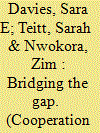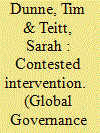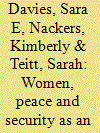|
|
|
Sort Order |
|
|
|
Items / Page
|
|
|
|
|
|
|
| Srl | Item |
| 1 |
ID:
139840


|
|
|
|
|
| Summary/Abstract |
Women, Peace and Security (WPS) scholars and practitioners have expressed reservations about the Responsibility to Protect (R2P) principle because of its popular use as a synonym for armed humanitarian intervention. On the other hand, R2P’s early failure to engage with and advance WPS efforts such as United Nations Security Council (UNSC) resolution 1325 (2000) has seen the perpetuation of limited roles ascribed to women in implementing the R2P principle. As a result, there has been a knowledge and practice gap between the R2P and WPS agendas, despite the fact that their advocates share common goals in relation to the prevention of atrocities and protection of populations. In this article we propose to examine just one of the potential avenues for aligning the WPS agenda and R2P principle in a way that is beneficial to both and strengthens the pursuit of a shared goal – prevention. We argue that the development and inclusion of gender-specific indicators – particularly economic, social and political discriminatory practices against women – has the potential to improve the capacity of early warning frameworks to forecast future mass atrocities.
|
|
|
|
|
|
|
|
|
|
|
|
|
|
|
|
| 2 |
ID:
140415


|
|
|
|
|
| Summary/Abstract |
This article examines institutional patterns of leadership and followership in the UN Security Council with respect to the Responsibility to Protect principle. In a departure from existing literature on leadership and followership in international relations, which has hitherto been framed within a realist analysis, the article presents a constructivist account of leadership that sheds light on the strategies and scope of conditions for mobilizing international action to protect populations from mass atrocities. The article applies a theoretical innovation to case studies that examine strategies that India and China adopted in the Security Council to respond to the crises in Libya and Syria from 2011 to 2013. This integration of theory and empirics reveals a complex and layered account of factors that shape the Security Council's ability to exercise its Responsibility to Protect. In doing so, the article demonstrates that followership and leadership are relational practices that create or limit the possibilities for institutional action.
|
|
|
|
|
|
|
|
|
|
|
|
|
|
|
|
| 3 |
ID:
108081


|
|
|
|
|
| Publication |
2011.
|
| Summary/Abstract |
When the term 'responsibility to protect' (R2P) was introduced in 2001, it was conceived as signifying a framework primarily aimed at legitimizing the use of force against states to protect populations from egregious abuse. China initially condemned the principle, then later endorsed R2P at the 2005 World Summit and reaffirmed its endorsement in the UN Security Council. This article examines the shift in China's position, which seems to run counter to China's stance on sovereignty, non-interference and the use of force. It asserts that China has gradually sought to distance the R2P principle from military action taken without the consent of the host state, and to limit the impact of R2P on robust civilian protection in consent-based UN peacekeeping. In doing so, China has adeptly managed to avoid some of the image costs of obstructing the UN effort to prevent and respond to atrocities, without ceding ground on its core peacekeeping policies and priorities.
|
|
|
|
|
|
|
|
|
|
|
|
|
|
|
|
| 4 |
ID:
176526


|
|
|
|
|
| Summary/Abstract |
In spite of ASEAN’s perceived inertia, there appears to be domestic pressure in key member states for a more activist approach.
|
|
|
|
|
|
|
|
|
|
|
|
|
|
|
|
| 5 |
ID:
130969


|
|
|
|
|
| Publication |
2014.
|
| Summary/Abstract |
The Association of Southeast Asian Nations (ASEAN) Secretariat and its member states have repeatedly professed their commitment to the protection and advancement of women's economic and human rights. Such commitments have included the Declaration of the Advancement of Women in the ASEAN Region in 1988, the Declaration on the Elimination of Violence against Women in the ASEAN Region in 2004, and the ASEAN Human Rights Declaration in 2012, as well as the establishment of the ASEAN Committee on Women in 2002 and the ASEAN Commission on the Promotion and Protection of Women and Children in 2009. However, none of these regional commitments or institutions expressly take up the core concern of the Women, Peace and Security agenda set out in United Nations Security Council Resolution 1325 in 2000. ASEAN has no 1325 regional action plan and, amongst the ASEAN membership, the Philippines is the only state that has adopted a 1325 National Action Plan. The authors explore the possible reasons for the lack of ASEAN institutional engagement with 1325, outline the case for regional engagement, and suggest specific roles for the ASEAN Secretariat, donor governments and individual member states to commit to United Nations Security Council Resolution 1325 as a regional priority.
|
|
|
|
|
|
|
|
|
|
|
|
|
|
|
|
|
|
|
|
|